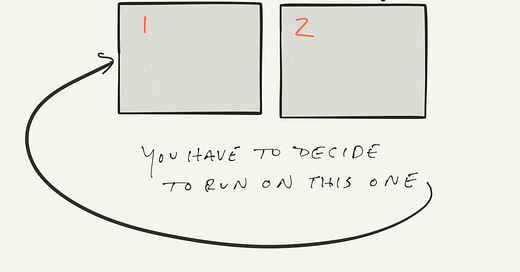Getting Back in Shape
I’ve fallen out of shape, in varying degrees, a dozen or so times over the past decade. Here’s what I’ve learned about what it takes, for me at least, to get back in shape:
I get in shape by running. I love to run for many reasons that have nothing to do with getting in shape. I’m a better person when I’m running. I do other exercises, but mostly I stick to running.
When I’m in shape, running feels like my natural state (i.e. painless and more efficient than walking); for extended periods of time on a run, I can forget about the fact that I’m running.
If I run every day, it takes me about two months, and perhaps a little longer, to get back in shape. In college it took me a few weeks, and in my 20s it took me about a month. A good part of the difference isn’t age, it’s that lately I’ve let myself get more out of shape.
The beginning and end of this process are still a mystery to me. I haven’t identified the combination of factors that prompts me to start the process, or the combination that interrupts it.
The process is always painful, even if I go easy at first. If I’m not feeling uncomfortable in the initial stages, I’m not really getting back in shape.
On a given day, the run isn’t optional. It’s not a matter of willpower because the decision has already been made. The biggest of the big ideas is to commit to a daily rhythm. To put it another way:

At the outset of this process, it helps if I don’t think about the process at all, but instead think about the first day, or the first few days:

In terms of running, I’m a transistor: either I run every day or I tend not to run at all. Another way to put this is that I need a daily rhythm (and again, I have to take away the option of not running)…
Once the process is started, though, it’s self-sustaining until something interrupts it (again, I’m not sure what that is, but it tends to be abrupt). Some will say that if I didn’t run every day I could sustain my running for a much longer time. My experience tells me the opposite; I believe it’s genetic. I also believe that bad habits aren’t broken, they’re replaced.
It’s a natural law as sure as gravity that success is inevitable through earnest effort over time. I believe that’s true in life, barring extreme poor luck, but it’s unquestionably true in terms of fitness. In fact, one of the great reassurances we all have is the simple cause-effect relationship between daily exercise and better fitness.
I’ve found that if I do the following three things on a daily basis, I’m guaranteed to get back in shape: drink less alcohol (or no alcohol); go to bed early; and get up at the first alarm. The rest takes care of itself.
Fitness and motivation are part of a virtuous circle. I call it a positive spiral (there are other positive spirals that I’ll note in a future post):

Weight is not the best indicator of fitness. Here’s what I shoot for (often my weight will increase a bit for up to a month):

I don’t track the number of minutes or miles I run, at least until I get back in shape. The number of miles isn’t the most important thing. The point is to preserve the daily rhythm. But in general, this is what tends to happen (notice how long it takes the mileage to increase; on the order of months, not weeks):

If you want to get an old friend to open up with you about his or her life, ask the following question: “How’s your rhythm?” It’s the kind of question a person can take in any direction, and it promotes immediate introspection. My college cross country coach, Al Cantello, has asked me that question for years, and it always helps me put things in perspective.
“There is delight in the hardy life of the open.” -Theodore Roosevelt (inscription on a tablet at Theodore Roosevelt Island, Washington D.C.). It’s a rare joy indeed to run outside and breathe free!


